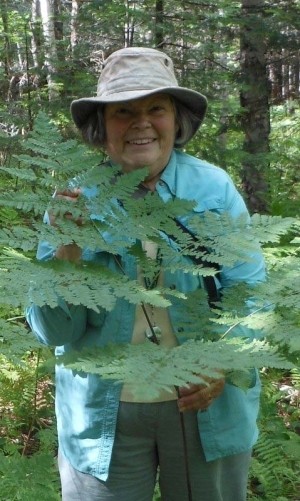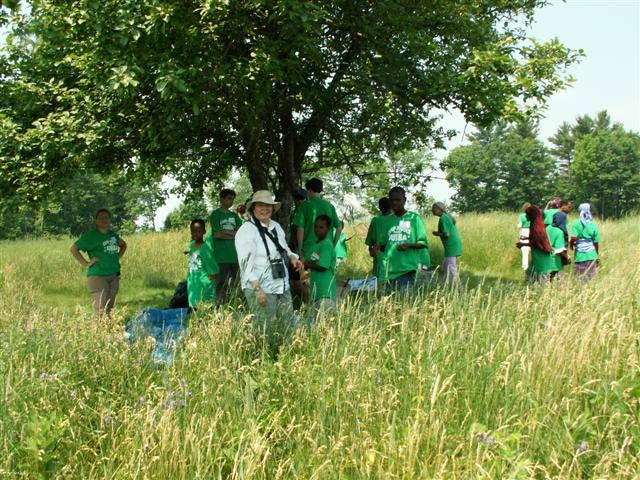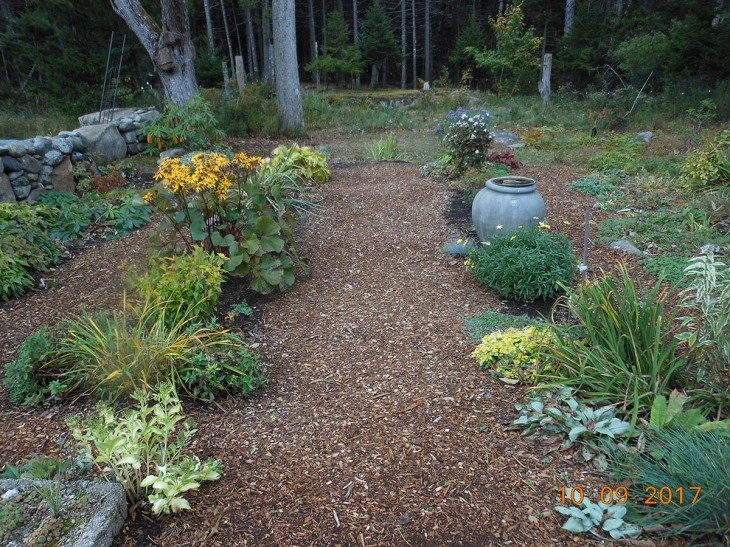
Growing up in suburban Washington, D.C, during the 1960s, Susan Hayward considered herself a “serious science kid.” During college at the University of Maine, she turned her attention to the natural sciences, particularly botany. Her career has been spent in education, from middle school classrooms to college lectures, and from teaching 4th graders in the field to helping to establish the Maine Master Naturalist Program, which has fostered the next generation of naturalist-educators. Now retired, Susan and her husband Tom spend the warm months on Mount Desert Island and the rest of the year in Brunswick, Maine.
I was an urban child, and my sacred outdoor space was a very small, but wild to me, corner of our yard in a Maryland suburb. It had enormous mature red oak trees and lots of forest floor duff to explore. It was here that I became familiar with spiders, which were my first introduction into the fauna of duff – what was there when you drilled down in. Spiders were just part of a spectrum of things that were in the duff in that little corner.
During the year I was in 7th grade, we lived on a remote lake in Minnesota. That opened my eyes to the wider world of the great outdoors. My sisters and I also spent weeks at our grandparents’ cabin in the woods in Dexter, Maine. We walked the trails and fields in the area, and I began to enjoy the landscape so different from my otherwise suburban life. My grandmother would take walks with me down into the woods. I don’t have a strong memory of what we discovered, and I don’t think she used the woods as a place for flora and fauna discovery. She used it as a place for solitude and regeneration.
Growing up outside Washington, D.C., in the ’60s, I was part of the “Sputnik” kids who were encouraged to pursue science and “beat the Russians.” As a result, I entered many science fairs locally and at the state level. My science fair projects were somewhat predicated on my summer jobs, including one summer working a clerical job at NASA’s Goddard Space Center, and another working for the U.S. Department of Agriculture in a lab. The picture you should imagine is me in our basement in the suburbs of Maryland, and I’m a mad scientist. I’m in 11th grade or 10th grade, and I’ve got maybe 25 lab rats in a cage, plus a menagerie of pet canaries, cats, Irish setters, gerbils, guinea pigs, ducks from the pond – all in a little suburban lot.
Becoming a “naturalist” was an organic process rather than a deliberate decision at a certain time. That focus on chemistry and physics did not fade away until I got to college. I loved all science. I had dedicated and creative professors, who had a seminal effect on my career path. There were people in the botany department who were young and had newly minted PhDs and just had a passion. They decided the department needed to be completely redesigned. They gave lectures on the fly. We felt so engaged in this grand experiment. It was very dynamic. I’m sure that’s what got me hooked on botany.
The University of Maine is a forestry school. Even the social scene was often about hewing logs and Paul Bunyan. I had a double major in education and botany. I studied ornithology and dendrology as well as botany, but mostly I sought every opportunity to spend time in the woods and waters with anyone who knew more than I did about a natural history topic.
Most of my teaching in public schools was at the high school level – physical science and biology, and then finally AP biology with older kids. That was very rewarding. One of the high schools was in Orono, Maine, and they had a lot of land out back. One year, the seniors built a nature trail for the elementary school, which was right next door. That was a good training ground for me. They had to do interpretive work for the trail, and they had to do the physical labor and the design work, and then the trial-and-error with real 3rd graders, so we even got in the pedagogy. It was a challenge to figure out how the 18-year-olds could convey the teaching message to the 3rd graders in an appropriate way.
The Thorncrag Nature Sanctuary represents the core of my professional career as a naturalist. This is a 415-acre sanctuary within the city of Lewiston, which has been owned by the Stanton Bird Club since 1921. When we moved to Lewiston in the 1970s, I sought out the bird club and learned about Thorncrag. The sanctuary had been without stewardship since about 1960, and it was clear that someone needed to salvage it. I designed a program for 4th graders and filled the sanctuary with students. They learned about food webs in the fall, in the winter they did adaptation and winter survival, and in the spring they did vernal pools. Once the stewardship was restored and programs begun to use the land appropriately, it recovered well. I was involved with Thorncrag for more than 30 years, as the staff naturalist and teacher and as a steward. It continues to thrive under new leadership and stewardship.
Since in 1977, I’ve been a member of the Josselyn Botanical Society. It’s a venerable organization, over 100 years old, made up of lay botanists and professionals and PhDs. It runs the spectrum of people interested in botany. We get together for a week in the summer somewhere in Maine and go out on these forays, all day long. I have spent a lot of time in every conceivable habitat in the state of Maine. We enter remote areas where there are rare plants or rare habitats. We happily get on a bus and bump down logging roads to remote spaces in Maine. We’ve been in every county of the state and every back corner of those counties.
In 2011, Dorcas Miller, naturalist, gathered several friends in her kitchen to pose the idea that environmental awareness and community commitment to conservation practices were more necessary now than ever. Basically, she said Maine needs more naturalists, and we created the Maine Master Naturalist Program. She wrote and won a grant for seed money, and four of us worked for a few months to design a program that would train adults in natural history topics over the course of a year. The grads would be required to return to their community and volunteer for 40 hours of outreach to schools and town entities to share what they learned with others.
We have a tremendous applicant pool for our courses. We’ve got name recognition and “street cred” now, and people understand the rigor and value that we’re offering. The basic model has not changed. Some new topics have been added to the curriculum. It is an 11-month rigorous course covering approximately 12 topics. Some years have supported two to three courses concurrently and therefore, in the 10 years of our program, we have held a total of 15 courses in locations all over southern Maine, resulting in 210 graduates. These men and women form a critical core that we call the Maine “Nexus of Naturalists.”
Most of my naturalist life has been head-down sharing the wonders of nature with others. It is all about conveying, in the best way possible, the importance of observing the details of our habitats.
I now put a lot more energy into horticulture and garden design and landscape work on our property on Mount Desert Island. I have a diverse garden of 214 perennials, which are all on an Excel spreadsheet. Only about 40 percent of it is natives. It’s got perennial borders where I can experiment with zone and heat sinks and micro-niches. There’s a wetlands layer anchored by a stream, sedges, willow, and ferns. Beyond that is a ledge, where I plan to put in rock gardens.
What I love most about spending time in the woods is solitude. Quiet. Mysteries. Old friends. My old friends are all the things that I’ve learned, things that I didn’t know going in. Whatever happens to be in front of me is now a friend, however old. Some of it’s fairly new, since I’m still learning. The lifelong learner tag is so evident in being a naturalist. You could do it until you die. It’s just endless.





Discussion *